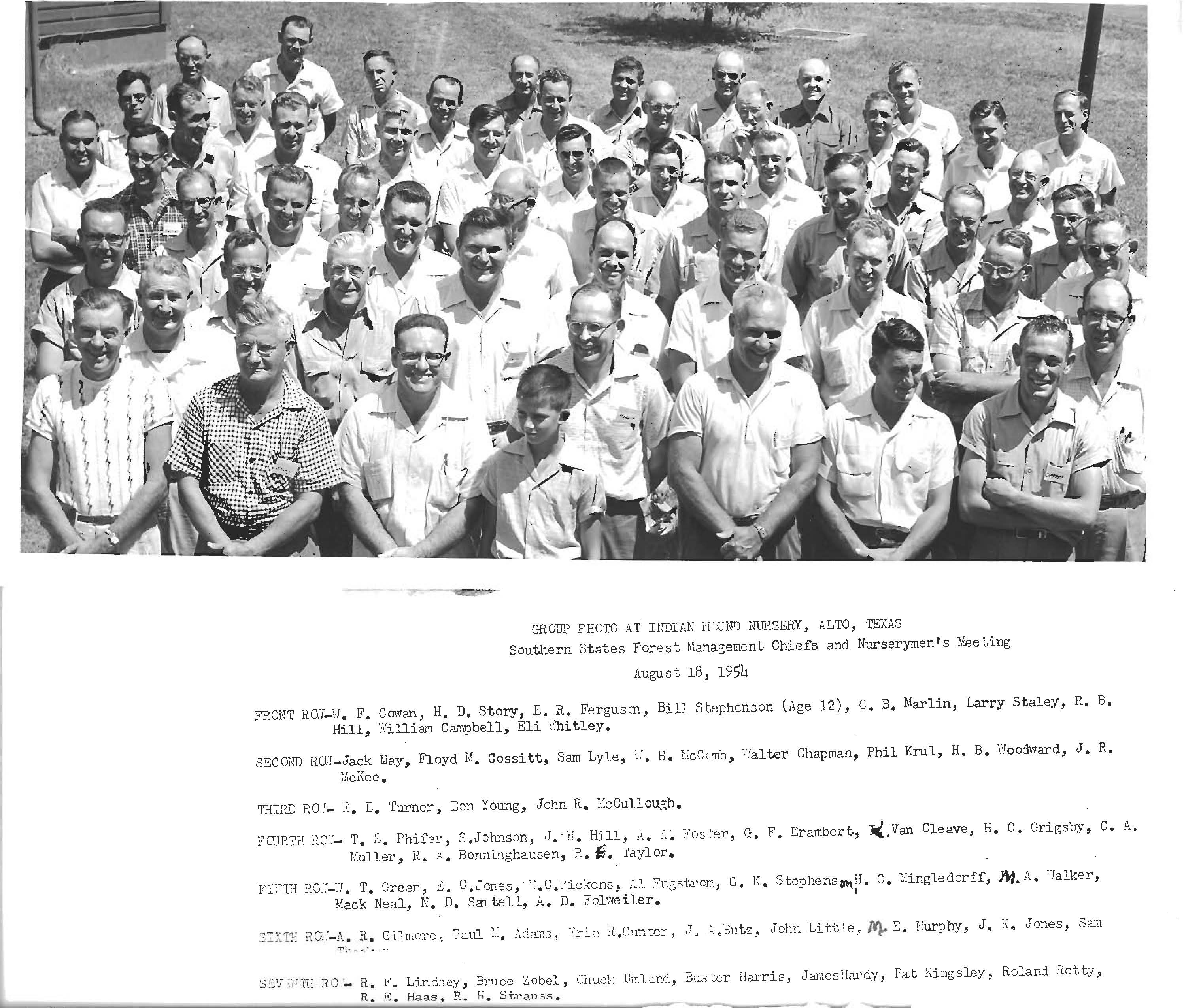Old Photos, 1900 to 1954
 Southern States Forest Management Chiefs and Nurserymen's Meeting
Southern States Forest Management Chiefs and Nurserymen's Meeting
August 18, 1954 - Indian Mound Nursery - Alto, TX
 Plantation of slash pine (Pinus elliottii) made in 1931
Plantation of slash pine (Pinus elliottii) made in 1931Seedlings (1+0) were planted 3.05 by 3.05 meters (10' x 10') or about 1076/ha (450/acre). Tallest trees in stand about 9.1 m (30') high. Average about 7.6 m (25') average dbh 13 to 15 cm (5 to 6") with maximum of 18 cm (7"). T.R. Miller Mill Company, Inc. Brewton, Alabama.
Photo taken by Clint Davis. 1939.
Credit: U.S. Forest Service. (photo #414221)
Note: The intended market for this plantation was for solid wood products.
 Soil moisture meter
Soil moisture meterKnown as a "tonometer"; set up in experimental nursery beds. Scale at left is in centimeters of mercury. Scale at right gives readings in total moisture percent. Hugo Sauer Nursery (Wisconsin).
Photo taken by J.H. Stoeckler. September 1937.
Credit: U.S. Forest Service. (photo #352548)
Note: Today this would be called a tensiometer. Does anyone know if "tonometer" is correct or just a misspelling?
 Shortleaf pine (Pinus echinata) seedlings
Shortleaf pine (Pinus echinata) seedlings1+0 seedlings that were not shaded (left) and that were shaded in the nursery (right). Ozark National Forests, Arkansas.
Photo taken by James M. Wait 1931.
Credit: U.S. Forest Service. (photo #260580)
Note the etiolation of shaded seedlings on right.
 Shortleaf pine (Pinus echinata) seedlings
Shortleaf pine (Pinus echinata) seedlings1+0 seedlings that were not not root-pruned (left) and those that were root-pruned in the nursery (right). Ozark National Forests, Arkansas.
Photo taken by James M. Wait 1931.
Credit: U.S. Forest Service. (photo #260582)
Note the increase in lateral root development on pruned seedlings.
 Sowing longleaf pine (Pinus palustris) seeds
Sowing longleaf pine (Pinus palustris) seedsCivilian Conservation Corps. At the left, different stages of seedbed preparation may be seen. In the center, men are hand sowing longleaf seeds. On the right, men are laying down burlap bags as a mulch. Kisatchie National Forests, Louisiana.
Photo taken by J.D. Nellis, 1934.
Credit: U.S. Forest Service. (photo #287379)
Note: Loblolly pine was a minor species in the 1930s since most trees were being planted with solid products as the objective. From 1936 to 1940, about 30 million longleaf seedlings (total) were produced annually at the Ashe Nursery at Brooklyn, Mississippi and at the Stuart Nursery near Pollock, Louisiana (Wahlenberg 1946).
 Shortleaf pine (Pinus echinata) seedbeds
Shortleaf pine (Pinus echinata) seedbedsHandweeding at the Stuart Nursery near Pollock, Louisiana
Photo taken by M.A. Huberman, October 1935.
Credit: U.S. Forest Service. (photo #310266)
Note: High seedbed density.
 Pesticide application
Pesticide applicationPumping allyl alcohol from drum to sprayer tank. Michigan
Photo taken by E.D. Clifford. October 10, 1953.
Credit: U.S. Forest Service. (photo #480841)
Note: Allyl alcohol was used as a soil fumigant.
 Sprinkling seedbed with disinfectant
Sprinkling seedbed with disinfectantPhoto taken by E.S. Shipp, 1929.
Credit: U.S. Forest Service. (photo #310266)
Note: Disinfectant was likely diluted sulfuric acid.
 Shipping seedlings
Shipping seedlingsPart of 1,708,000 seedlings for reforesting in the Allegheny National Forest, Pennsylvania.
Photo taken by H.C. Frayer. April 20, 1938.
Credit: U.S. Forest Service. (photo #361610)
 Loblolly pine (Pinus taeda) seedlings
Loblolly pine (Pinus taeda) seedlingsGrade 1 seedlings grown in the one-parent heritability study. SC Forestry Commission Nursery at Georgetown, SC.
Photo taken by A.L. MacKinney, 1936.
Credit: U.S. Forest Service. (photo #322445)
Note: These are not Grade 1 seedlings according to today's standards. The term "Grade 1" was mainly in regards to seedling height. Wakeley did not use root-collar diameter as a measure of seedling grade for loblolly, slash, or shortleaf pine in his 1935 publication "Artificial Reforestation in the Southern Pine Region."
 Callaway Foundation Nursery
Callaway Foundation NurserySome of the first genetic tests of the southern pines were conducted in Georgia at Callaway Gardens. Studies involving different families of loblolly pine and slash pine were outplanted in 1952. Two seedling grade studies were outplanted in 1954. Note the direction of seed drills and the use of boards to help reduce soil erosion of seedbeds.
Photo taken by Jack May, 1952.











